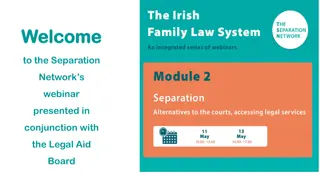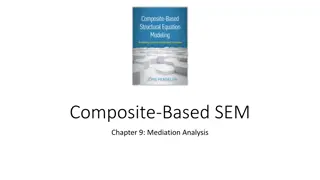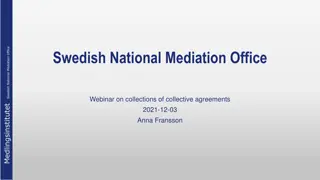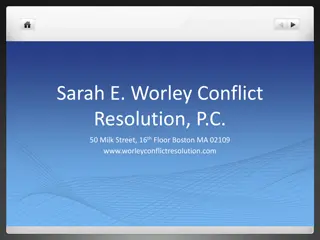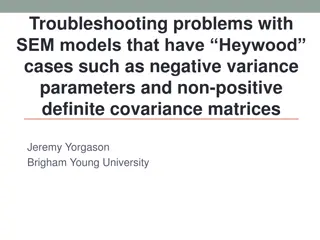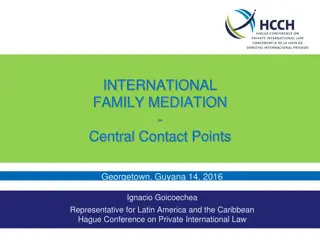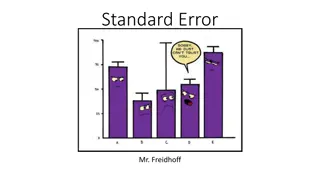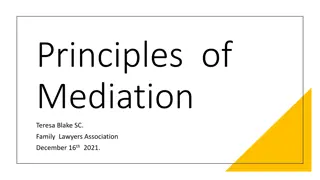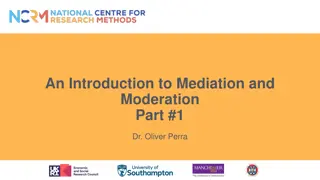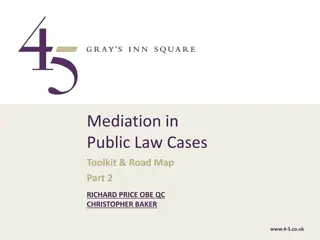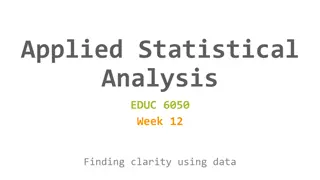Understanding Mediation Analysis in SEM Models
Mediation analysis in structural equation modeling (SEM) explores how the influence between two constructs can take an indirect path through a mediator. Key concepts include direct effect, indirect effect, and total effects. The process involves testing for significant relationships between variables to determine mediation presence. Over time, methods for testing mediation have evolved beyond the original Baron and Kenny approach, recognizing that indirect effects can exist even with non-significant direct paths.
Uploaded on Jul 22, 2024 | 0 Views
Download Presentation

Please find below an Image/Link to download the presentation.
The content on the website is provided AS IS for your information and personal use only. It may not be sold, licensed, or shared on other websites without obtaining consent from the author. Download presentation by click this link. If you encounter any issues during the download, it is possible that the publisher has removed the file from their server.
E N D
Presentation Transcript
Mediation Analysis Using AMOS IBM SPSS AMOS Series
Introduction to Up to this point, we have focused on how one construct can directly influence another construct in a SEM model. Mediation Let s now examine how the influence between two constructs may take an indirect path through a third variable called a mediator. In these situations, the third variable will intervene on the influence of the two constructs (Hair et al.2009). In testing if mediation or the presence of a mediator in a model, you need to understand some of the terminology that is used, such as direct effect, indirect effect, and total effects.
X Y c c in the relationship between X and Y is the total effect. A direct effect is simply a direct relationship between an independent variable and a dependent variable in presence of the Mediator (c ). M An indirect effect is the relationship that flows from an independent variable to a mediator and then to a dependent variable (a*b). a b X Y The term total effect is the combined influence of the direct effect between two constructs and the indirect effect flowing through the mediator (c = c + a*b). c Introduction to Mediation
Forms of Indirect Effects
How to Test Mediation The research by Baron and Kenny (1986) was one of the fundamental frameworks for how to test mediation. Over the years, research has refined their initial work on testing mediation. I think it is a worthy pursuit to discuss where mediation testing started and where it has progressed today. Baron and Kenny (1986) stated there were four steps to testing mediation: Step 1 make sure that X has a significant influence on Y (C path; absent of M at this point). Step 2 test that X has a significant influence on M (A path; no Y included); this needs to be significant for mediation to be present. Step 3 test that X has an influence on M and that M has an influence on Y (A and B paths); both paths need to be significant. Step 4 test the direct and indirect relationships simultaneously and determine if and what type of indirect effect is present (A, B, and C paths are all being evaluated).
Criticism on Baron and Kenny Approach The Baron and Kenny method was based on finding the unstandardized coefficients for each relationship and then determining significance using a Sobel test. As research has progressed, this method of testing mediation has changed, and Sobel testing has been rejected as a valid means of testing mediation. Even the initial steps outlined by Baron and Kenny have changed as well. The first step that the C path needs to be significant is not a requirement anymore. Indirect effects can be present even if a non- significant C path is initially found. The justification is based on the idea that there are suppressor effects that prevent the C path from being significant, but the indirect effect is still present. The idea that the A path and the B path have to individually be significant has been rejected as well. Hayes (2018) notes that an indirect effect is the product of the A and B paths, and statistical significance of either the A path or the B path is not a requirement for mediation.
How to Test Mediation The revised method is now concerned with assessing the indirect effect by examining the product of the A path and the B path while controlling for the direct effect of the C path. Since the Sobel test is flawed for this type of test, the more accepted approach in mediation testing is to use a bootstrap technique to determine significance. A bootstrap technique treats your data sample like a pseudo-population and then takes a random sample with replacement to determine if your indirect effect falls within a confidence interval. You can request the number of bootstrap samples to increase the accuracy of predictions (the higher, the better). A bootstrap sample of 5,000 is sufficiently large, and any greater number of samples will produce very little difference. Note that with a bootstrap sample, the computer program will generate a completely different sample every time you run the analysis. With 5,000 samples, the differences will be small, but the exact numbers in the results will not be the same if you run the analysis twice. To control for this, you can ask AMOS to always use the same seed number, which will produce the exact same results if you run the bootstrap analysis again. I will look into seed number in later videos
How to Test Mediation Let s look at an example in AMOS of a mediation test. Using the full structural model example, we want to examine if the construct of Authentic Leadership has an indirect effect through Self-Efficacy to the construct of Life Satisfaction. Notice that I am including a direct path from Authentic Leadership to Life Satisfaction. This will allow to see what type of mediation is present in the analysis Self-Efficacy Authentic Leadership Life Satisfaction
Analysis Properties To determine if the indirect effect of Authentic Leadership to Life Satisfaction is significant, we need to request from AMOS the indirect, direct, and total effects in the output. This will give all possible indirect effects in the model. To do this, select the Analysis Properties button , and when the Analysis Properties pop- up window appears, go to the Output tab at the top. On that tab, you will see at the top right an option for Indirect, direct, and total effects . Select this option.
Bootstrap Properties Next, we need to request a bootstrap analysis in AMOS. To do this, go to the bootstrap tab at the top of the Analysis Properties window. On that tab will be a checkbox called Performbootstrap ; click that box. AMOS will initially give you a default number of200 samples. This is way too small. Change the number of samples to 5,000. You will also need to select the Bias- corrected confidence intervals checkbox. AMOS will default a 90% confidence interval, but significance in most research is at the .05 level, so you need to change this to a 95% confidence level.
Analyzing the Results Let s look at the output to determine if mediation is present. In the Estimates link, you want to select the Matrices link. This will let you see the total effects, direct effects, and indirect effects for each relationship in your model. We want to select the indirect effects. AMOS will give you the option to examine the unstandardized or standardized indirect effect. With most mediation analyses, you will see the unstandardized indirect effect reported. If you were looking to compare indirect effects within a model, you could easily do so with the standardized indirect effects, but normally, the unstandardized indirect effects are reported. In the IndirectEffects tab, you will see all the possible indirect effects in your model. We are concerned only with the relationship of Authentic Leadership to Life Satisfaction through Self-Efficacy. In our model, we have only one possible mediator from Authentic Leadership to Life Satisafaction, so the indirect effect listed must be through the mediator of Self-Efficacy. (If you have more than one mediator, I will discuss this in another tutorial.
Indirect Effect The Authentic (AUL_IV) to LS_DV through Self-Efficacy is .268 Indirect effect Leadership of
Analyzing the Output We now know the indirect effect, but we still need to know if the indirect effect is significant and if it falls within the 95% confidence interval generated by our bootstrap. The indirect effects tab will give us the indirect effect but nothing else. We need to go to the bootstrap analysis section to find the other information. On the left-hand side, in a box below the output links is a section called Estimates/Bootstrap . Under that link will be another option called Bias-corrected percentile method . This is where we will find all the information, we are looking for concerning confidence intervals and significance levels. With the confidence intervals, you are going to get an upper bound and lower bound estimate of the indirect effect based on your bootstrap of 5,000 samples. If the range for the upper and lower bound estimates do not cross over zero, then the indirect effect is considered significant.
Interpretation of Results These are the results from the Bias- corrected percentile method link. It will first present the lower bound indirect effects and then the upper bound indirect effects. With our indirect test of Authentic Leadership to Life Satisfaction through Self-Efficacy, the lower bound confidence interval is 0.188 and the upper bound is 0.346. Since there is no zero between the LB and UP CI, this shows significant indirect effects.
Interpretation of Results The values of 0.015 at the intersection of AUL_IV and LS_DV shows Tailed Significance. the Two In this case it is .015 which is less than 0.05. Hence, we can conclude that Self-efficacy mediates the relationship Authentic Leadership and Life Satisfaction. between
Interpretation of Results Based on these results, we can conclude that Authentic Leadership has a significant indirect effect on Life Satisfaction through the Self- Efficacy. The indirect effect of Authentic Leadership to Life Satisfaction is .268. a*b (0.454*0.590) Next, let s look at the same output for the confidence intervals generated by our bootstrap. The lower bound confidence interval is .188 and the upper bound is .346. Since this confidence interval did not cross zero, we know that the indirect effect is significant. We know that the indirect effect is significant, but now we need to assess what type of mediation is present. Is it full mediation or partial mediation through the Self-Efficacy? To accomplish this, we need to examine the C path, or the direct path, from Authentic Leadership to Life Satisfaction in the Estimates link in the output. We can see that Authentic Leadership has a significant relationship to Life Satisfaction (p = .197, p < .001). This means that the influence of Authentic Leadership on Life Satisfaction is partially mediated through the construct of Self-Efficacy.
Mediation Analysis The study assessed the mediating role of self-efficacy on the relationship between authentic leadership on life satisfaction. The results revealed a significant indirect effect of impact of authentic leadership on life satisfaction was positive and significant (b= 0.268, t = 6.70, p = .015), supporting H1. Furthermore, the direct effect of authentic leadership on self-efficacy in presence of the mediator was also found significant (b = 0.197, p = 0.000). Hence, self-efficacy partially mediated the relationship between authentic leadership and life satisfaction. Mediation analysis summary is presented in Table 1. Table 1. Mediation Analysis Summary Relationship Direct Effect Indirect Effect P-value Conclusion Confidence Interval Lower Bound Upper Bound Authentic Efficacy -> Life Satisfaction Leadership->Self 0.197 (.000) 0.268 0.188 0.346 0.015 Partial Mediation How to Report Mediation Analysis
References Collier, J. E. (2020). Applied structural equation modeling using AMOS: Basic to advanced techniques. Routledge.





